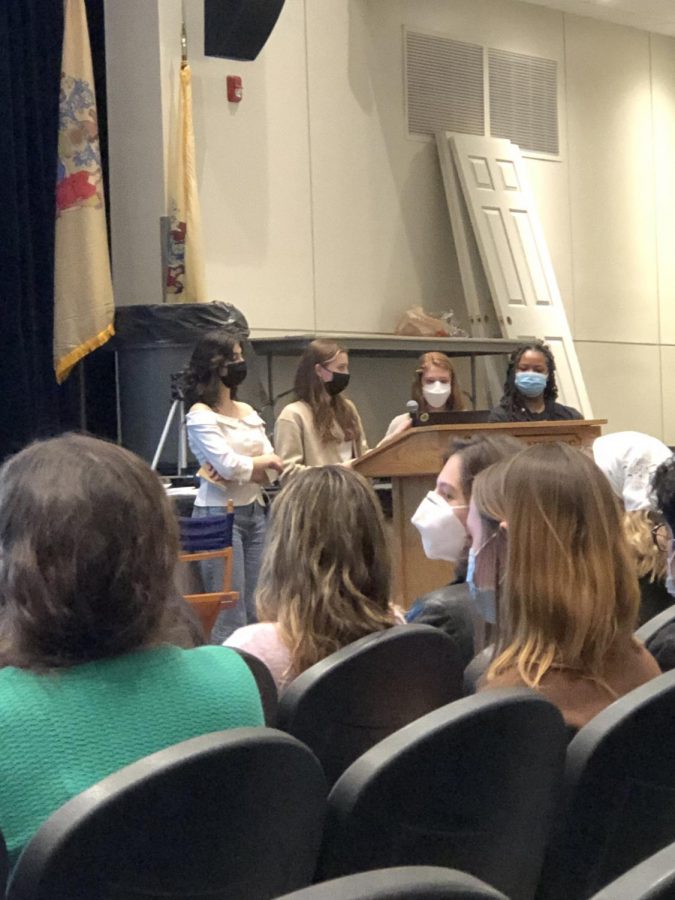First year Women’s Studies class takes action on school dress code
Since the first day of school, room 221 — housing the first year of West Milford’s Womens’ Studies class — has been buzzing with a brewing movement. According to Mia Grizzuti, a senior in the class, the topic of the dress code became the class agenda within the first days of school in reaction to numerous announcements from administrators. Mrs. Cheryl Botsolas has inspired 30 young students to create change within the school and present the staff with their proposed ideas and guidelines regarding the current dress code outlined within the student handbook.
The morning announcements contained messages generally targeted toward the school’s female population, according to the Women’s Studies class, and students in the class felt uncomfortable with the wording of such announcements, including one which “encouraged students to think of the administration” while choosing their outfits.
The class brainstormed multiple tactics to begin the process to inspire the change they hoped would better the environment for the student body as a whole. Thus, they created a poll in order to gauge the attitude of the student body and their opinions on the dress code issue. The poll was spread through social media and QR codes, and the class received about 270 responses. The class members felt the results from the school-wide poll affirmed their desire for change and brought their grievances to the administration’s attention. They drafted a letter detailing their purpose, data, and action taken.
According to Botsolas, students were met with “support from Mr. Strianse and the rest of administration,” and the class saw this as a positive step to begin the discussion. According to the students, they met with the various members of administration multiple times before all participating stakeholders agreed that the students must next address the faculty as a whole.
Several speakers from the class then took the helm at the November 2 high school faculty meeting to present the statistics from their poll and their work/process thus far. Women’s Studies students Grizzuti, Delaney Brown, Rebecca Benowitz, and Reyna Singleton began the faculty meeting with the rest of the class watching in support from the front of the auditorium.
Each student spoke regarding their personal opinions on the issue, what they had learned from the student body, and dispelled various concerns that had come about during the process. They started with an anecdotal quote a student left on the survey,
“I have never felt more humiliated in my life than when I was asked to stand up and prove that my shorts met the top of my middle finger […] or stand up in front of the class to show that my outfit wasn’t appropriate attire […] In those moments all of the self-confidence I worked so hard to achieve was gone.”
They then moved to share statistics to try to emphasize the urgency of their cause, according to their poll 100% of students are not distracted by others in violation of the dress code, and 75% of those who took the poll felt limited in expressing themselves due to the dress code. Following their presentation, which ended with a description of the proposed new dress code, the floor was opened up to the faculty for questions.
Since then, the proposed dress guidelines have been edited and amended in response to the staff concerns submitted through a questionnaire. Some staff was worried about the possibility of swimwear being worn to school, and others wanted clearer definitions within the restrictions sections of the dress code regarding hate speech and inappropriate language on clothing. The class took all of the staff’s suggestions into consideration and reintroduced the edited guidelines to Mr. Strianse.
The class is looking to implement this dress code at the high school on a trial basis and evaluate the impact of the changes by the end of the school year, hopefully making these proposed guidelines official at the high school by September of 2022.
The class has been met with little resistance to achieving its goals. Botsolas credits that to the “proper process” the students have taken, and she values the change in the school as much as “confidence and lessons the students are gaining from the process.” While this is the first year the Women’s Studies class is offered at WMHS, it has been a long fight for Botsolas, “I have been wanting to teach this Women’s Studies class since I became a teacher… it was shot down because it would take away from other classes in the department,” she was told.
She believes the class was able to be offered and successfully populated when she had a female supervisor who “understood how important this was, so then it was actually brought to the Board of Education [to be approved and go through the education committee].” She hopes soon that this course, as well as the “Struggle for Acceptance: Learning from the Past and Empowering the Future” course offered in the second half of the year, will become full-year courses. While Botsolas had planned to teach about activism within different parts of the women’s rights movement, rallying to modify the school dress code wasn’t necessarily part of the curriculum. However, Botsolas saw the passion driving her students and the importance of the class learning and championing for changes they wanted to see, so she made it the focus of her fourth-period class. While the future course of action is unclear regarding administration and the Board of Education, be sure to visit thehighlandecho.com for future updates.


